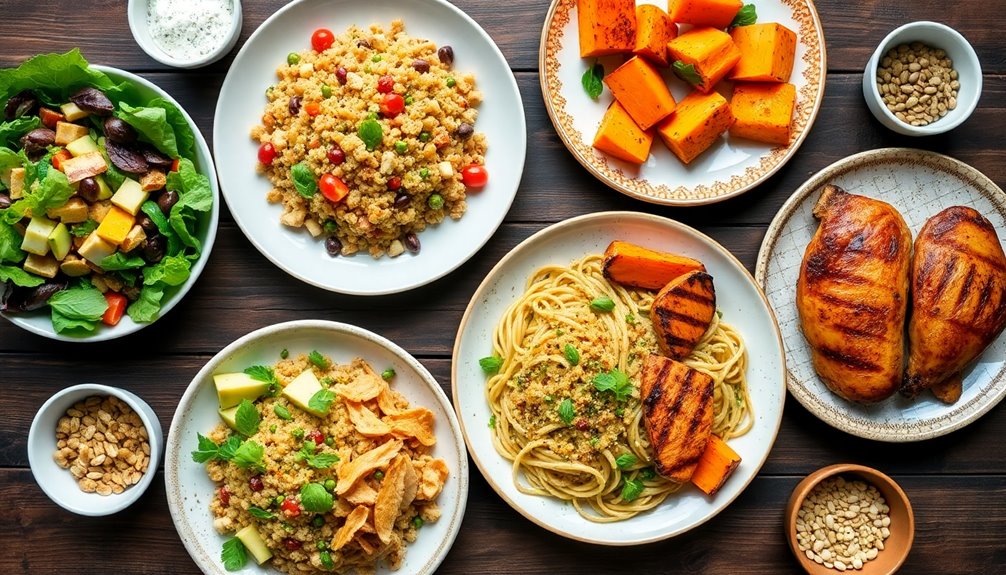Customizing meal plans for different dietary needs starts with identifying specific restrictions like allergies or preferences. Next, comprehend your nutritional requirements, balancing macronutrients and micronutrients. Utilize meal planning tools to assist with recipe suggestions and shopping lists. Don't forget to incorporate variety and flavor; experimenting with ingredient substitutions can enhance your meals. Finally, plan for meal prep and storage by labeling containers and keeping track of freshness. This approach not only guarantees you meet your dietary needs but adds enjoyment to your meals. There's plenty more to explore when it comes to making your meal plans truly personalized.
Key Takeaways
- Assess individual dietary restrictions, allergies, and cultural preferences to create personalized meal plans.
- Incorporate a balance of macronutrients and focus on micronutrient-rich foods for optimal health.
- Utilize meal planning tools and apps for recipe suggestions, shopping lists, and efficient meal prep.
- Experiment with ingredient substitutions to enhance flavor and accommodate dietary needs, like using zucchini noodles for low-carb diets.
- Label and date meal containers for proper storage, freshness monitoring, and to prevent food waste.
Identify Dietary Restrictions

When crafting a meal plan, identifying dietary restrictions right from the start is crucial. This step not only ensures safety for those with allergies but also fosters an inclusive atmosphere for everyone involved.
Begin by discussing allergen management with your family or friends. Ask about any known allergies, sensitivities, or intolerances. This conversation is vital; even small traces of allergens can trigger serious reactions.
Next, consider cultural considerations that may impact food choices. Different cultures have unique dietary practices, whether due to religious beliefs, traditional customs, or lifestyle choices.
For instance, some individuals might follow vegetarian or vegan diets, while others may avoid specific food groups like pork or beef. By acknowledging these factors, you create a meal plan that respects everyone's preferences and promotes a sense of belonging. Additionally, incorporating health benefits of a vegan diet can provide nutritious options that cater to various dietary needs.
When you gather this information, be open and understanding. It's important to show that you value each person's needs, which helps build trust and camaraderie.
From there, create a list of acceptable ingredients that cater to everyone's dietary restrictions. This collaborative approach not only enhances the meal planning process but also helps you develop dishes that everyone can enjoy together.
Understand Nutritional Requirements
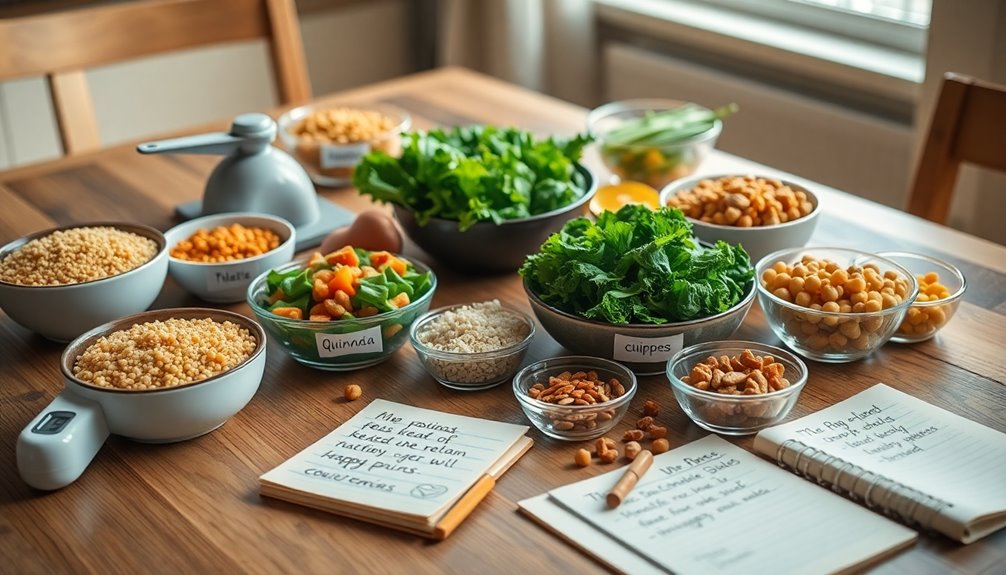
Understanding your nutritional requirements is [KEY] for creating a meal plan that not only meets dietary restrictions but also supports overall health and well-being. To do this effectively, you need to focus on macronutrient balance, which includes carbohydrates, proteins, and fats. Each of these macronutrients plays an [IMPORTANT] role in your body's functions. Additionally, following a well-structured custom keto diet can help in achieving specific health goals.
For example, proteins are [CRITICAL] for muscle repair, while healthy fats support brain health.
Portion control is just as [CRUCIAL]. By managing your portion sizes, you can help maintain a healthy weight and avoid overeating, which can lead to various health issues. Being mindful of how much you're consuming helps [ENSURE] that you're getting the right balance of nutrients without excess.
Allergen awareness is key, especially if you or someone in your household has food allergies. Always read labels and be cautious about cross-contamination. This awareness can prevent adverse reactions and help you feel more secure in your meal planning.
Lastly, don't overlook micronutrient intake. Vitamins and minerals are [ESSENTIAL] for various bodily functions, from boosting your immune system to maintaining bone health. Aim to include a variety of fruits, vegetables, and whole grains in your meals to [ENSURE] you're meeting these needs.
Explore Meal Planning Tools
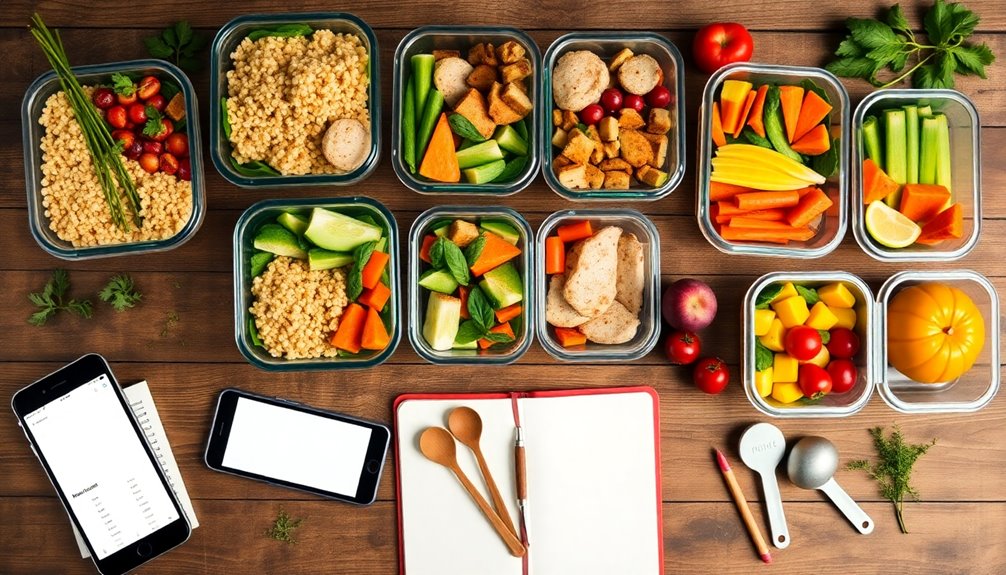
To effectively tailor your meal plans, utilizing meal planning tools can streamline the process and enhance your overall experience. These tools not only save you time but also help you maintain a balanced, nutritious diet that fits your unique needs.
One of the most valuable resources at your disposal is meal planning apps. These apps often offer a variety of recipe suggestions, making it easy to find meals that cater specifically to your dietary requirements. Whether you're vegan, gluten-free, or following another specific diet, you can discover new dishes that align with your goals. Many apps even allow you to input your dietary preferences, making certain you receive personalized recommendations.
Another great feature of these tools is their ability to assist with ingredient substitutions. If you're allergic to a certain food or simply want to swap out an ingredient for health reasons, meal planning tools can suggest alternatives that maintain the recipe's integrity while accommodating your needs. This flexibility allows you to experiment with flavors and textures without feeling restricted.
Moreover, meal planning tools often include shopping lists that simplify your grocery trips. By automatically generating a list based on your selected recipes, you can make sure you have everything you need, reducing the chances of impulse buys that derail your dietary goals. Additionally, adopting a plant-based diet can lead to a longer lifespan, making meal planning tools an essential resource for those transitioning to veganism.
Incorporate Variety and Flavor
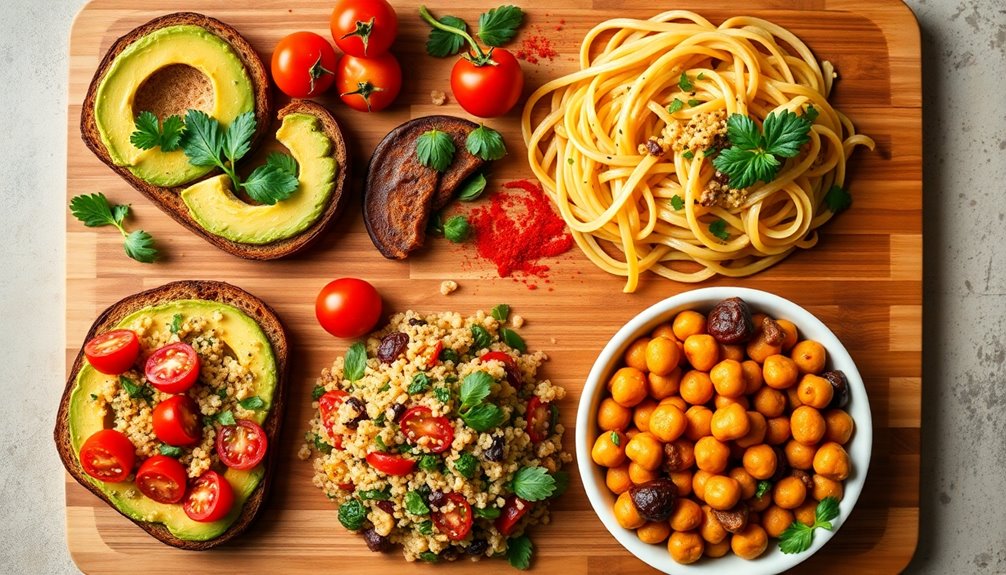
Incorporating variety and flavor into your meal plans not only keeps your meals exciting but also guarantees you're getting a wide range of nutrients. When you embrace diverse flavor combinations, you enhance your meals while ensuring you're consuming different vitamins and minerals. Think spices, herbs, and sauces that can transform a simple dish into a culinary delight.
For example, try adding fresh basil to a tomato salad or a dash of cumin to your roasted vegetables; these small changes can make a huge difference.
Don't hesitate to experiment with ingredient substitutions. If you're looking to reduce carbs, swap out traditional pasta for zucchini noodles or cauliflower rice. Craving a creamy texture? Opt for avocado instead of mayonnaise or yogurt. These substitutions not only cater to dietary restrictions but can introduce you to new flavors and textures you mightn't have considered before. Additionally, exploring Keto recipes can provide you with numerous options to maintain flavor while adhering to dietary goals.
To keep things fresh, plan a weekly theme for your meals. One week could focus on Mediterranean flavors, while another could explore Asian cuisine. This approach not only keeps your taste buds engaged but also encourages creativity in the kitchen.
Make Adjustments for Preferences

Adjusting meal plans to fit your personal preferences can make all the difference in your eating experience. When you customize meals to your taste preferences, you're more likely to enjoy what you're eating and stick to your plan. Here are three practical ways to make those adjustments:
- Identify Your Taste Preferences: Take some time to think about what flavors and textures you love. Do you enjoy spicy dishes, or are you more into savory flavors? Knowing this helps you choose recipes that excite you.
- Use Ingredient Substitutions: If a recipe calls for an ingredient you don't like or can't eat, don't hesitate to swap it out. For instance, if you're not a fan of broccoli, you might replace it with green beans or spinach. This guarantees you still get the nutritional benefits without sacrificing taste.
- Experiment with Seasonings: Sometimes, all it takes to transform a meal is a different seasoning. Try adding herbs, spices, or sauces that mirror your personal taste. A dash of garlic powder or a sprinkle of fresh basil can elevate even the simplest dishes. Additionally, incorporating whole-food sources of protein can enhance the nutritional value of your meals.
Plan for Meal Prep and Storage
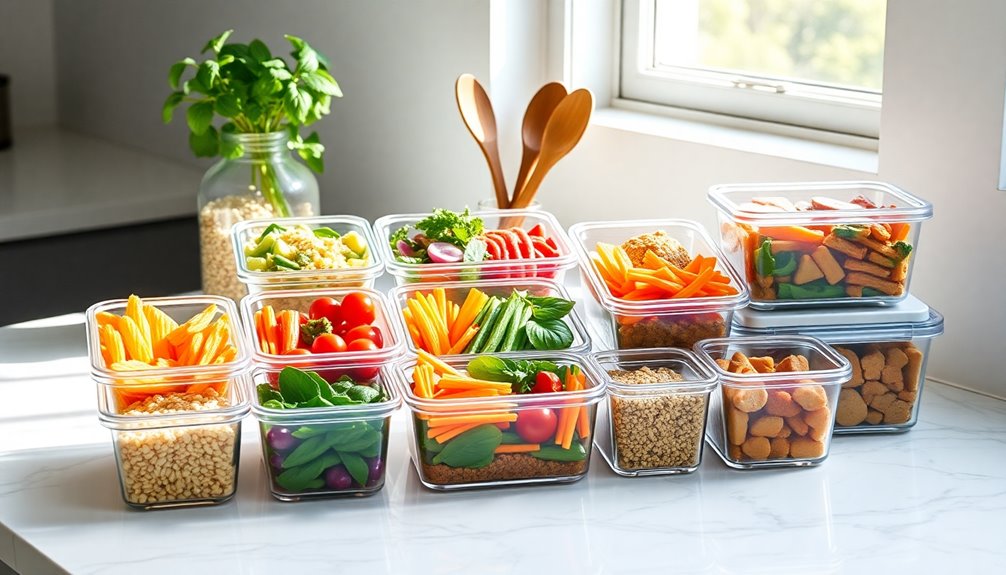
Meal prep and storage can be your secret weapons in maintaining a healthy eating routine. When you take the time to plan out your meals, you not only save time during the week but also make it easier to stick to your dietary goals.
Start by organizing your kitchen; a clean and structured space can streamline your meal prep process. Use clear containers for ingredients and prepped meals, labeling them to avoid confusion.
Consider making ingredient substitutions that align with your dietary needs. For instance, if you're following a low-carb plan, swap out traditional pasta for zucchini noodles. Prepare these substitutes in advance so you can easily incorporate them into your meals. This not only enhances the nutrition of your dishes but also keeps things interesting. Additionally, incorporating effective snoring exercises can help improve your overall health and ensure better sleep, which is vital for maintaining a healthy lifestyle.
Once your meals are prepped, focus on proper storage methods. Invest in good-quality airtight containers to keep your food fresh and safe. Store meals in the fridge for quick access or freeze extras to prevent waste. Remember to label everything with dates to monitor freshness.
Frequently Asked Questions
How Do I Account for Food Allergies When Meal Planning?
When you're meal planning, it's important to account for food allergies. Start by identifying all dietary restrictions and avoid any allergens. Use alternatives to replace problematic ingredients with safe options.
For instance, if someone's allergic to dairy, try almond milk or coconut yogurt. Accommodating these needs guarantees everyone can enjoy the meals together, fostering a sense of belonging.
Can I Customize Meal Plans for Weight Loss or Gain?
You can customize your meal plans for weight loss or gain by focusing on macro tracking and portion control. Start by determining your daily caloric needs, then allocate macros—carbs, proteins, and fats—based on your goals. Portion control helps you manage intake without feeling deprived. Remember, it's all about balance and finding what works for you. Personalize your meals, and you'll create a plan that feels satisfying and sustainable!
What Are the Best Sources of Protein for Vegetarians?
If you're seeking the best sources of protein as a vegetarian, consider exploring various plant-based protein options.
Lentils, chickpeas, and quinoa are excellent choices that pack a protein punch.
You can also try protein substitutes like tofu, tempeh, and edamame.
Incorporating nuts and seeds into your meals can enhance your protein intake, too.
How Can I Make Meal Prep More Efficient?
To make meal prep more efficient, start by planning your meals for the week.
Use time-saving tips like batch cooking staples and chopping veggies in advance.
You can also employ ingredient substitutions to keep things fresh and exciting.
For instance, swap quinoa for rice or use canned beans instead of dried ones.
This not only saves time but also helps you stay connected with your meals, making the process enjoyable and fulfilling.
What Are Some Easy Snacks for Specific Dietary Needs?
Did you know that 80% of people struggle to find quick, healthy snacks that fit their dietary needs? You're not alone!
For portable options, consider almond butter packets with apple slices, or hummus with veggie sticks. Greek yogurt topped with mixed berries is another tasty choice.
These snacks aren't only satisfying but also cater to various diets, making it easier for you to stay on track while feeling connected to your health goals.
Conclusion
Customizing meal plans for different dietary needs doesn't have to feel like rocket science. By identifying restrictions, understanding nutritional requirements, and incorporating variety, you can create delicious meals that cater to everyone. Don't forget to adapt for personal preferences and plan for easy prep and storage. With a little creativity and the right tools, you'll turn meal planning from a chore into a culinary adventure. So roll up your sleeves and start cooking up some magic!

